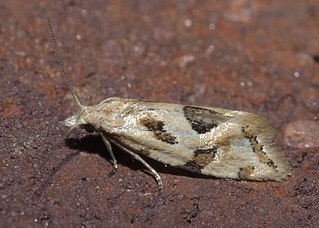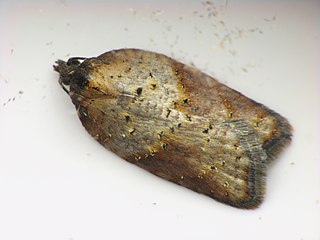
The Tortricidae are a family of moths, commonly known as tortrix moths or leafroller moths, in the order Lepidoptera. This large family has over 11,000 species described, and is the sole member of the superfamily Tortricoidea, although the genus Heliocosma is sometimes placed within this superfamily. Many of these are economically important pests. Olethreutidae is a junior synonym. The typical resting posture is with the wings folded back, producing a rather rounded profile.

The Tortricinae are the nominate subfamily of tortrix moths. Commonly referred to as leafrollers, as the larvae build shelters by folding or rolling leaves of the food plant, the tortricinae include several notable pests as well species used as biological control agents against invasive weeds.

The Archipini are a tribe of tortrix moths. Since many genera of these are not yet assigned to tribes, the genus list presented here is provisional.

Chlidanotinae is a subfamily of moths in the family Tortricidae.

The Cochylini are a tribe of tortrix moths. It used to be classified as the subfamily Cochylinae.

Clepsis is a genus of moths belonging to the family Tortricidae. It includes several notable pest species.

Argyrotaenia is a genus of moths in the tribe Archipini within the family Tortricidae.

Acleris is a genus of moths belonging to the subfamily Tortricinae of the family Tortricidae. As of 2007, about 241 species were known.

Aethes is a genus of moths belonging to the subfamily Tortricinae of the family Tortricidae.

Cochylis is a genus of moths belonging to the subfamily Tortricinae of the family Tortricidae.

Phalonidia is a genus of moths belonging to the subfamily Tortricinae of the family Tortricidae.
Aphalonia is a genus of moths belonging to family Tortricidae.

Eugnosta is a genus of moths belonging to the family Tortricidae.
Netechma is a genus of moths of the family Tortricidae.

The Atteriini are a tribe of tortrix moths.

The Euliini are a tribe of tortrix moths.

The Tortricini are a tribe of tortrix moths.
Alexey Nikolaievich Diakonoff, also transliterated as Alexej Nikolajewitsch Diakonoff, was a Russian–Dutch entomologist who specialised in Microlepidoptera.
Józef Razowski is a Polish entomologist and lepidopterist specializing in Tortricidae. He is an honorary member of the Polish Entomological Society and a working member of the Polish Academy of Arts and Sciences (PAU). From 1988 to 1997, Razowski headed the Institute of Systematics and Evolution of Animals.
Aphalonia praeposita is a species of moth of the family Tortricidae. It is found in Colombia.














